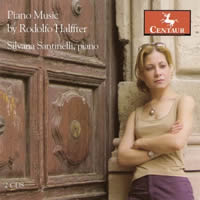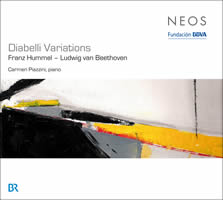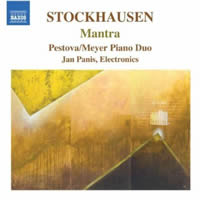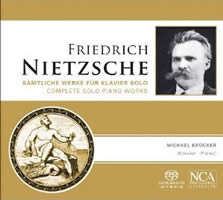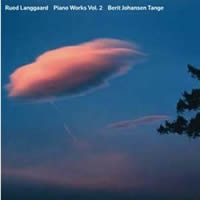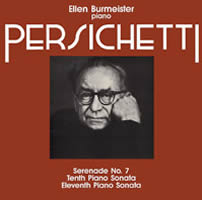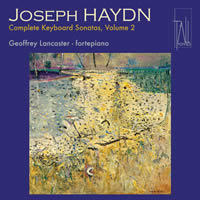Piano Factory 7.
|
Grant Chu Covell [July 2011.]
Rodolfo HALFFTER: Primera Sonata, Op. 16 (1947); Once Bagatelas (1949); Secuencia, Op. 39 (1977); Danza de Avila (1936); Preludio y Fuga (1932); Tres Rojas de Album, Op. 22 (1953); Apuntes para Piano (1936-82); Dos Sonatas de El Escorial, Op. 2 (1928); Homenaje a Arturo Rubinstein (Nocturno), Op. 36 (1973); Segunda Sonata, Op. 20 (1951); Homenaje a Antonia Machado (1944); Dos ensayos (1979); Minuet de la Traviesa Molinera (1934); Tercera Sonata, Op. 30 (1967). Silvana Santinelli (pno). Centaur CRC 2928/2929 (2 CDs) (http://www.centaurrecords.com/). Distributed in the US by Qualiton (http://www.qualiton.com/). I’ve been dipping into this fluent sampler between more difficult stuff, enjoying Halffter’s compact brightness and Santinelli’s flair and execution. Halffter (brother of Ernesto and uncle to Cristóbal) might flirt with neo-Classicism (Dos Sonatas de El Escorial) or serialism (Tres Rojas de Album), but admiration for Mozart and Scarlatti lurks beneath Spanish colors and piquant dissonance. In particular, the First Sonata stands out with a cadential figure whose added sevenths and seconds twist across the keyboard. Halffter seems to have favored small movements: Considering these 47 tracks, only one, the dreamy but serial Homenaje a Arturo Rubinstein, exceeds five minutes.
Franz HUMMEL: 33 Veränerungen über einen Walzer von Anton Diabelli (2006-07). Ludwig van BEETHOVEN: 33 Veränerungen über einen Walzer von Anton Diabelli, Op. 120 (1819-23). Carmen Piazzini (pno). NEOS 20807/08 (2 CDs) (http://www.neos-music.com/). Distributed in the US by Qualiton (http://www.qualiton.com/). Beethoven fashioned miracles from Diabelli’s “cobbler’s patch.” We demand similar machinations should anyone else pick up the same threaded needle. Hummel’s variations appropriate the title and comment upon Beethoven as much as they twist Diabelli’s theme, but the work soon diverts into a game of Who’s Who? After the obligatory Brahms and Chopin nods, I tired of marking obvious references (Ligeti in No. 7, Piazzolla in No. 16, Prokofiev in No. 19, boogie-woogie in No. 33, and so on). The notes suggest buried references to friends and colleagues. Piazzini scrubs vigorously, but where Beethoven demands an interplanetary ride, we only get out to the suburbs.
Karlheinz STOCKHAUSEN: Mantra (1970). Xenia Pestova, Pascal Meyer (pnos), Jan Panis (electronics). Naxos 8.572398 (http://www.naxos.com/). Karlheinz STOCKHAUSEN: Tierkreis (1975-77); Klavierstück IX (1954-63); Klavierstück V (1954); Klavierstück XI (1956); Litanei from Aus den Sieben Tagen (1968, realized by Elisabeth Klein); Plus-Minus (1963, realized by Nils Holger Petersen). Elisabeth Klein (pno). Scandinavian Classics 220555 (http://membran.net/en/Editions_Label/Classical/Scandinavian_Classics/index.html). Distributed in the US by Naxos (http://www.naxos.com/). Mantra heralds Stockhausen’s return to precision. It was also his first work to employ the “formula” structure that would occupy him the rest of his days. Adding woodblocks, vocalizations, chirpy crotales and zinging electronics, this two-piano opus pokes fun at preceding two-piano serial compositions by Boulez, Fano and Goeyvaerts with its overt repetition and continuous recycling. The keyboards’ athletic banter may infrequently give way to humor, but I find that this release’s tangy ring modulation makes the 67-minute journey more bearable. The work’s heralded structure has always struck me as convoluted and tedious. Panis worked with Stockhausen, who approved the digital signal processing. Sometimes the treatment is prominent, other times it’s a subtle background space-sound whirr. Kudos to Naxos if this awakens fresh Stockhausen interest. I would have to assume that Klein meant to provide a sample of Stockhausen’s piano works and not marginalize the composer. Her program dramatizes earlier points that for all his promise, Stockhausen’s star fizzled early. Despite Klein’s delivery, it’s remarkable how unmusical Stockhausen can become. He intended the opening music-box zodiac cycle, Tierkreis, to be more approachable than the knotty Klavierstücke, however I hear only ersatz folk tunes. Then follows the (in)famous Klavierstück IX with its repeated chord, which other than those initial 139 repetitions is unmemorable. Is Klein making the case that Stockhausen was unmusical? Two tracks realize works that are simply instructions or convoluted diagrams. Petersen’s single-page version of Plus-Minus takes 13:10 and is littered with trivial gestures, none of which is actually Stockhausen. Klein’s collage for Litanei from Aus den Sieben Tagen returns to mid-century plinking. We shouldn’t expect melodies or to hum Stockhausen in the streets, but there ought to be something distinctive that would compel a replay. I’m not as ambivalent when Stockhausen employs electronics or tape. Other entries include the strictly notated Klavierstück V and two versions of the 19-panel Klavierstück XI, whose style and dynamics are determined as the work is played.
Friedrich NIETZSCHE: Complete Solo Piano Works. Michael Krücker (pno). NCA 60189 (1 SACD) (http://www.ncamusic.com/). Distributed in the US by Naxos (http://www.naxos.com/). Retrospection confirms that something was not quite right with Nietzsche. If he hadn’t become a famous thinker, we wouldn’t be considering these pieces, notwithstanding an interest in the musical activities of philosophers. Wagner and Von Bülow derided Nietzsche’s music, thinking it derivative and inept. Certainly these are amateur pieces, and yet heartfelt scraps. Formal studies might have set Nietzsche upon a proper path. There are many places where Nietzsche’s creativity was hampered by his own keyboard skills, yet the would-be philosopher soldiered on. Krücker digs in wholeheartedly, and for those who must investigate, this supplants other collections and series.
“Piano Works Vol. 2.” Rued LANGGAARD: Smaa Sommerminder (1940); Afgrundsmusik (1921); Albumsblad (1904); Paa en Kirkegaard ved Nat (1907); Adorazione (1934); Piano Piece in E major (1951); Sommerferie i Blekinge (1916). Berit Johansen Tange (pno). Dacapo 6.220565 (1 SACD) (http://www.dacapo-records.dk/). Distributed in the US by Naxos (http://www.naxos.com/). Langgaard’s unceasing variety never fails to amaze. We might expect maturity or improved skills, but he took a reversion and was inclined towards exaggeration. Schumann looms large in this Danish loner’s universe: a 1904 album leaf, the first of the 1940 Smaa Sommerminder (“Little Summer Memories”), and an E-major arabesque from 1951. The collection Sommerferie i Blekinge (“Summer Holiday in Blekinge”) suggests lawn parties and leisure, whereas Hell is boldly characterized in Afgrundsmusik (“Music of the Abyss”), whose first part imposes a repeating Messiaenic pattern over a staunch chorale, Schumann gone polytonal at a croquet game.
Vincent PERSICHETTI: Piano Sonata No. 10, Op. 67 (1955); Serenade No. 7 (1952); Piano Sonata No. 11, Op. 101 (1965). Ellen Burmeister (pno). Starkland R-3016 (http://www.starkland.com/). Persichetti wrote piano sonatas throughout his life and in many different styles, from angular atonality dispensed into standard forms (Nos. 1 and 2 from 1939), American expansiveness (the 1943 Third offers a Declaration, Episode and Psalm) to the grand sweep of No. 10 and No. 11. Nos. 5, 7, 8 and 9 pass in less than 10 minutes each, whereas the Tenth and Eleventh are full-bodied efforts, the latter’s five movements the most appealing to these ears. The completist will want to tackle Persichetti’s dozen with Geoffrey Burleson on New World Records 80677-2 (2 CDs). Just one disc fewer and some 20 years prior, Burmeister cuts to the chase, offering greater shading and interpretive coloring. Listen to the Tenth’s opening tremolo gestures which flutter like butterflies compared to Burleson’s dispassionate Czernyesque motoring. In languid movements, such as the Eleventh’s central Sostenuto, Burmeister’s dynamics isolate the Bergian mainline from peripheral colorations. Yes, these 1985 tapings sound boxed-in and there are a few brief dropouts, but there’s so much warmth. I wish Burmeister had taped the Fourth. Persichetti’s serenades were written for solos and groups. The solo piano No. 7 encompasses six brief movements, Walk, Waltz, Play, Sing, Chase, and Sleep.
“Music of Stefan Wolpe, Vol. 6.” Stefan WOLPE: Four Studies on Basic Rows (1935-36); Three Pieces for Youngsters (1950); Lied, Anrede, Hymnus, Strophe zarteste Bewegung (1939); Two Pieces for Piano (1941); Toccata in Three Parts (1941); Studies for Piano, Part 1, Displaced Spaces (1946-48); Studies for Piano, Part 2 (1948); Two Dances for Piano (1926); Palestinian Notebook (1939); Songs without Words (1959). David Holzman (pno). Bridge 9344 (http://www.bridgerecords.com/). And now you can take one in the other arm. Holzman returns to administer 73 minutes of Wolpe’s sturdy solo-piano medicine. So much outright dissonance might be hard to stomach, but Wolpe offers wit, ample expression, and even unexpected folk colors, viz. Palestinian Notebook. The Passacaglia from the Four Studies on Basic Rows and the bruising Toccata in Three Parts with closing double fugue offer the grittiest dissonance. The flinty statements within Studies, Part 1 pass in seconds. When Wolpe tries his hand at the popular music he might have bumped into in 1926 Berlin, a Blues and Tango, we get dense chords, spluttering accents and devil-may-care dissonance. Where does Holzman get all his energy?
“Complete Keyboard Sonatas, Volume 2.” Franz Joseph HAYDN: Sonata No. 30 in D major, Hob. XVI: 19 (1767); Sonata No. 53 in E minor, Hob. XVI: 34 (1780-83); Sonata No. 38 in F major, Hob. XVI: 23 (1773); Sonata No. 16 in D major, Hob. XVI: 14 (1761-67). Geoffrey Lancaster (pno). Tall Poppies TP208 (http://www.tallpoppies.net/). Lancaster is on his way towards an exemplary fortepiano Haydn series. Possibly I may revise my preference for these sonatas on a modern instrument should Lancaster maintain this level of finesse and charm. No true musician finds Haydn’s prolificacy boring. Booklet notes are exceptionally detailed and thoughtful, and Lancaster introduces each sonata with an improvised prelude derived from contemporaneous material. These sub-minute warm-ups establish the key and provide a welcome flourish. Some will grumble at the background noise which sounds like a lightly humming HVAC. Lancaster alternates between two fortepianos made by Paul McNulty modeled on Stein and Walter originals.
[More Grant Chu Covell, Piano Factory]
[More
Beethoven, F Hummel, Haydn, Langgaard, Nietzsche, Persichetti, R Halffter, Stockhausen, Wolpe]
[Previous Article:
Random Noise 29]
[Next Article:
Random Noise 30]
|
